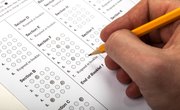Not all college courses are created equal. Many students take certain college courses because they are required for their major, while they take others as electives out of curiosity or for other reasons. What a student gains from a course can vary according the student's experience and how they evaluate the course sometimes determines how the professor will construct the course the next time it is offered. Professors rely upon the valuable input of thoughtful students who offer suggestions in their course evaluations at the end of the semester. Whether you are a professor looking to evaluate your own course or a student looking for some creative insight on how to evaluate a class you have taken, it is probably best to establish a set of criteria by which to judge the course as objectively as possible.
Step 1
Determine the applicability of the course for the evaluator. Depending on the class that is being evaluated, the student may or not have any interest in the course material itself. Sometimes this can taint the outcome of the evaluation. For professors, it is necessary to include a section in the evaluation to determine how important the responses may actually be to the student, according to Yale Univeristy. Someone majoring in math may not have anything positive to say regarding a history course. This is not always the case, of course, but the overall impact of answers coming from someone in another field may not carry as much weight as a student majoring in the field.
Step 2
Evaluate the instructor. Students' perceptions of courses are often tied to their overall assessment of the professor. Professors who engage the class in discussion, incorporate humor into the course and are generally sensitive to student needs and issues may receive a better overall evaluation from students than professors who read lecture notes and are indifferent to the plight of the student. Professors should learn not to take the evaluations personally, but depending on the student, the response may come across as a personal attack if the evaluation form includes space for the students to include suggestions and comments. Students presenting evaluations should remember that professors are well-trained scholars who, for the most part, are attempting to offer them the best possible education in their area of expertise on a particular subject. Students should limit critical statements to useful information the professor can use for future course offerings.
Step 3
Provide feedback for the course. Most course-evaluation forms will have some type of standardized questions or ratings systems. These forms usually include questions regarding the course workload, how challenging the course turned out to be, how well the assignments related to the material of the course, whether the text was useful and readable, and possibly, how fair the grading of the course appeared to be, Yale University notes. The more objective the form, the more useful it will be for the instructor.
Step 4
Provide tips and suggestions. Most evaluation forms will have a section at the end asking students to provide any comments they may have for the professor. Professors should take these to heart, but not so much so that they are discouraged by negative comments. Many students will actually have very creative suggestions to offer for improving the course while some will inevitably use it as an opportunity to vent frustration over the course. Again, students should try to remember that their responses will affect future students and should, therefore, not take this as an opportunity humiliate the professor.
Related Articles
References
Writer Bio
Jared Lewis is a professor of history, philosophy and the humanities. He has taught various courses in these fields since 2001. A former licensed financial adviser, he now works as a writer and has published numerous articles on education and business. He holds a bachelor's degree in history, a master's degree in theology and has completed doctoral work in American history.









